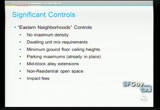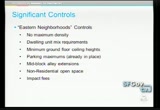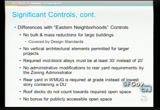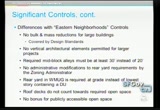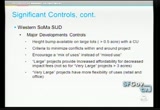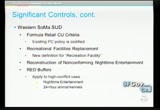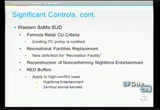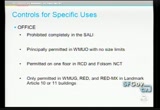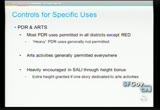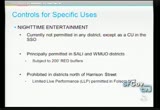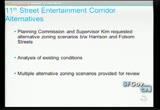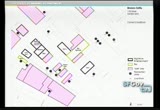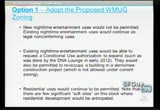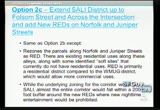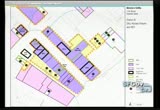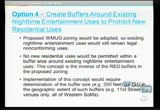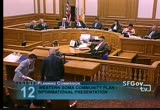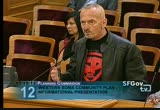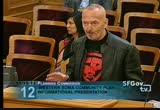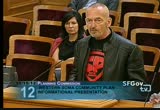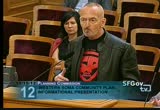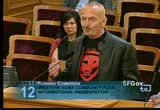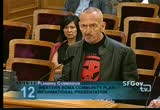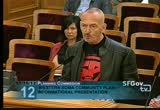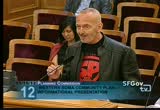tv [untitled] November 19, 2012 1:30am-2:00am PST
1:30 am
neighborhoods. in many ways it will plug into the eastern neighborhoods framework and one way of doing that is a lot of the controls that apply to eastern neighborhood mix use districts will apply to the districts in this area as well, so for example there's no maximum density. instead there is a dwelling unit mix, 40% two bedroom or 30% three bedroom and other physical requirements such as rear yard, open space, and dwelling expose and you are with all of those requirements you come to the appropriate de facto density on the site. most will have minimum ceiling heights like the mix use districts. parking has already changed in soma. that was actually proactively changed a couple years ago and no parking minimums but instead parking maximums and midblock alley extensions for large sites that
1:31 am
have long frontages afford them the opportunity to grant the alley extensions to interior alleys in the block and as you know they have some of the largest in the city. residential open space -- currently in soma we have this requirement and it's very low and the end user fee is low and in eastern neighborhoods and required and also given more appropriate rate and plug into that as well, and in terms of impact fees -- we will talk more about implementation near the end, but there is no near impact fee system or framework for western soma. it will plug in eastern neighborhoods. it will use the same tier system for the eastern neighborhoods and the same rates will apply. other significant controls to keep in
1:32 am
mind. obviously western soma and part of the eastern neighborhood but there are differences. that's one reason it was put out separately. we feel it's important to layout the differences and what would apply to other eastern neighborhood mixed use districts, so for large projects with large frontages in eastern neighborhoods there is a requirement to break up the bulk of mass within specific dimensions. the western soma code would not do that. although they would have similar type of controls that be placed in the design standards opposed to being in the code. also in eastern neighborhoods for large projects a project can propose a vertical element, non hab tabl element to be add and not permitted in western soma. the midblock alley extension that we were talking about and western
1:33 am
soma keeps it but extend its a bit and in eastern neighborhood the width is 20 feet and in western soma it would be 30 feet. under eastern neighborhoods right now under certain situationslet zoning administrator can be modifications and parking rear yard and open space. under western soma that would not be permitted. in western soma residential projects can build roof decks. they can have them but not permitted to use towards the open space requirement and staying on the theme of open space eastern neighborhoods give you a bit of a bonus if you're providing open space as common open space to all of the residents in the development but publicly accessible you don't have to provide as much and instead of 80 feet it's 54 feet per square unit and western
1:34 am
soma you wouldn't get that bonus so those are ways that western soma will differ from eastern neighborhoods if terms of significant control and there are a few others and instead of having them scattered throughout the code the plan is take the western soma special use district and defined the boundaries and started the planning effort and make it like most in the city and have it contain significant controls, so one of the main controls within the sud are the major developments that we talked about north of harris street on lots larger than half a acre. essentially they're given a base and max height and if they want to go over that height you can do that, but it requires conditional use authorization. there is specific criteria to meet and demonstrate to the
1:35 am
planning commission they have met. what it comes down to in a lot of ways they want to reduce conflicts with uses and encourage mix uses opposed to mix use projects and to explain that a little bit they don't necessarily want these large projects to be every building in the project to be ground floor retail and residential above. some of those maybe appropriate within the project but they think it maybe appropriate to have within a large project a stand alone office building and a stand loan residential building and other mixed use in three eakirs would also be required to provide increased affordability for the res residential component of the project but in exchange
1:36 am
required to pay a lower tier impact fee for the residential and very large projects which are generally greater than 3 acres because of the size and because use controls are often per lot when you get lots of that size, very large projects are given more flexibility with how much they may have of certain uses like retail and office. other uses and the special use district include the formula retail criteria. the planning commission adopted a policy some years ago, adopt the criteria for the retail and conditional use in western soma. this is basically codifying the policies into the special use district . we created new definition for recreational facility in the code and there is a requirement if a recreational facility in western soma is demolished or otherwise moved the project has to show there is enough capacity
1:37 am
of recreation facilities within the planned area to allow that demolition or removal or replace it as necessary. right now if you have a non conforming night time entertainment use and the building that it's in is demolished you cannot replace that use in that building. it's essentially boonted but one provision in the special use district would allow them to occupy a new building if the building they were in was demolished and also creates the residential enclave buffers. 200-foot buffer and basically says within that buffer irregardless of the under lying zoning is night time uses or 24 hour animal ken . >> >> kennels cannot be permitted. i think i have a map of that.
1:38 am
i think it's later. i want to talk about specific uses and how they're treated in the area. housing is a obviously a big deal. it's generally permitted everywhere north of harrison street and the enclave districts and the neighborhood commercial district all permit residential housing. south of harris street except for in the few enclave districts and alleys housing is not permitted so that's this alley and the wmuo. in terms of retail it's permitted in rad and you get more flexibility with it and with retail. there are limits to the size and kind ofs retail and restaurants or bars and general retear and varies by
1:39 am
district and there is a size limitation in any district in the planned area. in terms of office it is prohibited complete in the sally. currently had there is a small provision that allows work space professionals to be permitted but it's restrictive. i'm not aware of any projects that used that provision and the office is not permitted in the sally but principally allowed in the wmou and it's as office district. within the commercial districts on ninth, tenth and folsom one story of office is permitted and right now there is none on harrison street and it's only allowed in the wmoug in the
1:40 am
enclave districts and landmark or article 10 or 11 buildings. pdr and arts -- like a lot of districts in the city. most pdr uses are permitted as a right except in the rad except with the exceptions of some of the uses that are allowed in pdr1 and pdr2. arts activities and allowed in many districts? the city and. >> >> and in western soma protecting the arts is a big deal and generally committed throughout the planned area especially within the sally district. again this goes to the split height, the way that you chief the additional height in sally is dedicate one story in the building to permanent arts activity use and whichever story you dedicate is 15 feet
1:41 am
high so you get the extra 15 feet that way. night time entertainment -- currently not permitted in the district but as a conditional use in the sso and a small amount of the planned area. under the new zoning it would become principally permitted within the sally and the wmo districts except in the 200-foot buffers in the enclave districts and that opens up land that is not available for new night time entertainment to open up, but it prohibits north of harrison street and it's the way it is now and the neighborhood commercial districts and obviously in the enclave districts it's not permitted but important to note and live performances and accessory and piano player or something like that at a restaurant. that
1:42 am
will be permitod folsom street. and so here's just a quick map showing the buffers around the enclave districts. in the sally it did not show the buffers around the reason clarify districts. >> >> and no night time use is permit the there but allowed with enclave districts and that is a segue into a request made by the commissioner and supervisor kim that we present some alternative zoning scenarios for the 11th street corridor between harrison and folsom and that contains a cluster of entertainment uses and other related uses, so we did under go analysis and found existing conditions within that corridor and looked at multiple alternatives and we wanted to present those to you for your
1:43 am
review, so under the existing conditions you can see there are a number of night time entertainment uses. you have slims, dna, butter bar, mist, beat box, and you have a couple of vacant sites on the corner as well. we also have a couple of bars in the area, and there is a limited amount of residential development in the area too, right on 11th street and also in the surrounding area. although a large portion of those are live-work units and effectively function for the purpose of conflicts with other uses they function as residential uses. society first option to look at. >> >> for this area is basically as is in terms of as is proposed and that is keeping the corridor zoned wmug and what that would do is mean new night time
1:44 am
entertainment uses would not be permitted and the current uses are legal conforming uses like they have for the last 20 years. the existing night time uses could potentially expand 25% with conditional use and dna lounge that came before the commission to expand this year and they would allowed to reoccupy a building under demolition with the new code and they couldn't do under the current code. residential uses are allowed just as they are now, but there aren't many soft siteos that corridor where large amounts of residential development could take place. this is just a map showing what we already have proposed, so option 2a is -- there is 2a, 2b,
1:45 am
2c and variants and all of option two involves rezoning some portion of that corridor instead of wmug instead going to sally, so 2a essentially -- basically take all the properties here from harrison to folsom and zone those as sally and that is the only change and what that would do the night time entertainment uses that are there would be legal uses and new night time entertainment uses are permitted and no new residential uses are personalitied and the ones that are there would be legal non conforming uses and important note. sally even though it doesn't have the name of pdr district is essentially a pdr housing and doesn't allow housing or office but allows other things, and this gives
1:46 am
you look at 2a option. so 2b is essentially the same thing except jumping folsom street to capture the two corner lots. one reason is because one of the existing -- it's vacant but existing night time intraim entertainment location is on the north corner there and see the club and there is another varant taking it across folsom street and 2c is basically doing the same thing, rezoning the corridor to sally, but also taking the two alleys on either side of the corridor and taking the existing residential lots and soft sites within the alleys and making them new enclave districts for residential development exercise what that essentially does, and you can't
1:47 am
see it too well in the screen here but in the printow i believe you can. it does rezone sally so essentially new night time entertainment is permitted, but the buffers that we spoke about before would apply to these rad districts and the buffers would extend over that corridor except a small portion of the northern corner, the soft site, so essentially all of the corridor would not permit housing but it would not permit new night time entertainment, so essentially the existing entertainment uses would not have the threat of new housing directly on the corridor, but the residential units in the alleys wouldn't have the threat of new night time entertainment uses on the corridor either. so options 3a, b, and c are
1:48 am
similar except for the fact that instead of rezoning the corridor sally it would be wmuo, the office district and allows a lot of the same things as sally except no residential and does it allow office, so what you get here is again night time entertainment would be principally committed again. office uses would be introduced to the area and pdr uses can still go there but again no new residential uses would be permitted and the exiting residential uses on that front annual would be legal non conforming using then. and then option b is the same concept in terms of jumping folsom street to capture those two sites and option c is the same thing in terms of fusing the zoning but introducing the residential
1:49 am
enclave zoning within the alleys and you would get the same outcome in terms of no new night time entertainment but also no new residential on the corridor but with the introduction of office being permitted on the corridor. the fourth option we didn't map but it was an option raised and that is essentially to kind of do the opposite kind of buffer. we have the buffers for the residential enclaves. there could be an option for developing buffers for night time entertainment uses in this corridor to protect them from new residential within a certain distance whether it's 100 feet, 200 feet. implementation of that could be somewhat difficult but it definitely is an option that could be looked at and because it had various parameters didn't work out we didn't map it and we feel the concept is fairly
1:50 am
straightforward so a quick explanation of the alternatives without trying to be too complicated because they can get complicated, but i also wanted to give them an opportunity to give remarks how the task force came to the policy on night time entertainment use within the planned area. >> thank you cory and good afternoon president fong and commissioners. jim meeko, chair of the western soma task force. there is a section where cory summarizes goals or principles behind the plan and mentions dealing with
1:51 am
incompatibilities with entertain uses and the rest of the plan area. that kind of oversimplifies the case. it was much more important for us to deal with the broader issue of compatible and incompatible useds, and as kind of the test lab for mixed use in this city we are the first mixed use district that was established in 1990. we have a pretty good feel as to what works and what doesn't. clearly our goal is not to banish any incompatible uses. our goal is to figure out how to deal with all of them. you're going be hearing a lot more about this as the central corridor plan comes before you because at its extreme, and i might add in a rather
1:52 am
pollyannish way, they tend to put a lot of potentially incompatible uses all together. you will have housing. you will have office. you will have pdr, and you will have night time entertainment, and when they get to discussing how they're going to make all of that work i hope you will remember the discussion that we're having today. okay. everybody loves fun. you can't be against fun, and night time entertainment is an integral part of the fabric of south of market, so let me make it very clear from the very start there was never any notion of restricting -- putting on any additional restrictions on night time entertainment. our goal from the very beginning was to ensure we would find a better way to make it work together
1:53 am
and everybody is full a lot of good ideas to improve what we have. nobody wants to poor cold water on them but unfortunately the good ideas tend to involve somebody else's neighborhood. now we're talking about our neighborhood here. nobody understands the impacts of entertainment like the residents of south market. we have the greatest concentration of place of entertainment permits in the entire city, so no matter what anybody tells you south of market has the greatest concentration of places of entertainment of permits in the entire city, and they haven't been here for all that long. the night clubs actually began to come into south of market in the mid-80's. it's kind of a consequence of the aids
1:54 am
epidemic that with so many deaths, gay bars tended to close, and night clubs began to trickle in taking advantage of the opportunity of a lot of vacant space. south of market kind of went through a cycle for many years it was working class bars going back to the 1850's and going forward. working class bars morph into the gay bars which began to really proliferate in the early 70's and then as i say as the aids epidemic decimated our community when you lose 50 people a week you lose gay bars too. the influx of night clubs was not without conflict. leading to the 1990 rezoning
1:55 am
the filipino community took a strong stand they were offended by the impact that night time entertainment was bring to their neighborhood. the alleys around 11th street and the other residential enclave districts are full of working class filipino families and children. as we go through the plan i hope that you recognize something that many people don't notice the residential population south of market lives in the alleys and that's why the key goal of the western soma process is to improve things for our rads. the conflict between night clubs and neighbors got due to the worse state in the 90's when
1:56 am
gavin newsom proposed a night time entertainment zone. at first he was talking about 40 square blocks and eventually scaled that back to 11 ethstreet but the conflict between the night clubs and the neighbors got out of hand. countless clubs were taken to court. the residents in the area primarily the newer residents were certainly used to quieter surroundings and they certainly had the means and the law on their side to take many venues into court. on the other hand, the entertainment community fought back harshly when they felt the clubs were under siege and lead to at its worse a clear case of arson on the 15 unit residential building that was under construction at corner of
1:57 am
11th and harrison street just before it was ready to open it burned down to the foundation. the 1990 rezoning is predicated on opening south of market up to a denser residential population. you hear the same thing all the time, and that is a foundation of the current western soma community plan before you. we were actually given some pretty firm numbers of residential units that we should produce, and in fact in the eir we even created a higher growth alternative at director's ram's request to meet a higher threshold because the original eastern neighborhoods proposal for our area did not reach that kind of a goal. entertainment at the same time in the 1990 rezoning was recognized as
1:58 am
something that was worth preserving. preservation is the key word here. entertainment community is worried about losing their clubs and that is the further thing from our minds is to threaten any of the existing clubs. entertainment was grandfathered in. that means it's here now. it's here to stay. residential became as of right and that's throughout the entire south of market with the exception of the slo zoning areaand i understand and i was
1:59 am
involved with forming the entertainment commission so i understand entertainment issues very well, and i am not the enemy of fun. in eight years i think i supported every permit application that came before the commission with the exception of maybe three cases. what actually threatened entertainment in this city first of all are police and abc related issues. zoning has nothing to do with that. if you're creating noise or nuisance or out of compliance with your conditions you're going to
119 Views
IN COLLECTIONS
SFGTV: San Francisco Government Television Television Archive
Television Archive  Television Archive News Search Service
Television Archive News Search Service 
Uploaded by TV Archive on

 Live Music Archive
Live Music Archive Librivox Free Audio
Librivox Free Audio Metropolitan Museum
Metropolitan Museum Cleveland Museum of Art
Cleveland Museum of Art Internet Arcade
Internet Arcade Console Living Room
Console Living Room Books to Borrow
Books to Borrow Open Library
Open Library TV News
TV News Understanding 9/11
Understanding 9/11